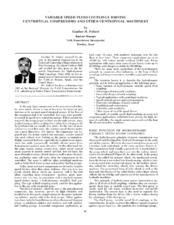| dc.description.abstract | In the past, large compressors in the petrochemical industry were mostly driven in one of two ways: by steam (or gas) turbines or by constant speed electrical motors. If the flow of the compressor had to be controlled, two ways were possible: to control its speed or to control its suction. If flow control was required, the steam (or gas) turbine was the right answer, since in-plant steam could be produced at a rather low cost (gas could be purchased for an equally low price). In the case of more continuous, even flow rates, the constant speed electric motor was a good alternative. For startup, the compressor was bypassed and, if a certain control was necessary, suction control was used without even looking at the power consumption. Highly increased fuel cost, especially for in-plant steam generation, has made commercially available electric power from large generating plants more attractive. On the other hand, for the same reason, energy conservation makes speed control much superior to suction control and last, but not least, the more diversified nature of feed stocks as well as more fluctuating production rates call more often for compressors to be controlled. The same is valid for other centrifugal machines such as boiler feed water pumps and pipeline loading pumps. Today, more and more compressors are driven by variable speed devices other than steam turbines. One way is to use purely electric drives, which are, however, still in the trial phase regarding large horsepower. Another, much more proven way is to use, in connection with a standard constant speed electric motor, a hydrodynamic, so-called, fluid coupling. The type of fluid coupling mostly used for this application is the one with integrated gears. This kind of machine, relatively new to the petrochemical community, has, however, proven its high reliability and availability in thousands of applications in the power generating industry, mostly with boiler feed pumps. Other applications have included installations in oil producing and shipping plants, on platforms offshore and onshore, and with pipeline and loading pumps. Successful compressor applications go back some 15 years, with numbers increasing over the last three to four years. These compressor applications go up to 10,000 hp, with output speeds reaching 12,000 rpm. Pump applications with many more years of case history exist up to 30,000 hp, with designs available for 60,000 hp. There are many more applications of the hydrodynamic principle in numerous other industries, in the form of fluid couplings and torque converters, as well as combined transmissions. The intention herein is to describe the hydrodynamic principle and its technical application in the following areas:
• Basic function of hydrodynamic variable speed fluid couplings
• Advantages of using such couplings
• Successful designs of such couplings
• Typical applications with centrifugal machines
• Speed control options and instrumentation
• Economic advantages of speed control
• Installation and maintenance
• Reliability and availability
• Other types of variable speed drives
Thousands of variable speed fluid couplings in pump and compressor applications worldwide have proven the high degree of availability, the simple maintenance needs and the long life of such wear-free machines. | en |


